The problem…
So, you have produced a video, uploaded it on YouTube, and for some reason, the audio is not loud as it should be?
Or, you have produced a video, uploaded it on YouTube, and for some reason, your audience is telling you that they can’t hear you clearly and that the audio is not loud as it should be?
Or, even worse, you have produced a video, uploaded it on YouTube, and for some reason, you have a much bigger bounce rate than usual, i.e. your audience is mostly watching just the start of the video?
What is going on?
The reason why your video is not performing that well could be due to low audio loudness. There could be other problems too, but I will focus on audio loudness which is my expertise.
Audio loudness is one of the most important characteristics when it comes to the perceived quality of the audio.
This is why decades ago commercials on TV were competing which one will be the louder, and this is why songs were overcompressed in the past too!
YouTube is normalizing audio loudness?
Yes! This is correct, and this is slowly becoming an industry standard for all streaming services!
So, how does audio normalization work?
After you upload the video on YouTube, their servers analyze its content for loudness and resulting values get assigned to the uploaded video. YouTube is looking for Integrated LUFS values and maximum peak values in dB.
Once this is done, they apply a gain correction based on the values they got.
YouTube is aiming for audio to be as close as possible to -14 LUFS integrated loudness while keeping audio peaks from clipping (distorting).
Note that YouTube will not increase the loudness of your video!
What is LUFS?
LUFS, also known as LKFS, is a relatively new measurement that was developed to take into account human hearing as best as possible. You can say that LUFS is an evolution of RMS measurement.
LUFS was developed as an effort to stop loud commercials from bursting your eardrums in between a quiet show on the television. Nowadays, playing audio at certain LUFS levels on TV is mandated by law in many countries like the USA for example.
If you are not familiar with this measurement, you can grab this free meter, and play around with it.
Why is YouTube normalizing audio?
Normalizing audio to the same loudness levels has one incredible advantage and that is that all videos you watch on the platform will have the same audio loudness. ![]()
This might sound stupid, but this solves a big problem in the past where you might need to adjust your device volume for every different video. As you might guess, that was pretty annoying for the user watching the videos.
This is a thing of the past, fortunately!
What is the target loudness for YouTube?
As a rule of thumb, you can aim for these values:
-14 LUFS Integrated
-1dB True Peak Max
What is a true peak?
True peaks are really similar to the regular peaks. In most cases, both will be the same, but in some cases, true peaks will be a bit higher.
What true peaks are showing you are actually the hidden peaks that could occur while audio is being converted from digital to analog form on some devices. If true peaks got too high, you might hear an audio distortion.
This is why it is important to keep true peaks in check. I would suggest using any limiter that has a true peak detection for solving this problem.
How can I achieve the -14 integrated LUFS?
You can do this in two ways.
The first and most basic one is to add more gain. That won’t work in the real-world in most cases though. This is because you will probably always have much quieter audio to work with, and if you push too much gain, you could start clipping the audio.
The most likely thing to happen is that you will have to compress the audio. That would be the second way of doing it.
You can also add gain while having the limiter that will keep peaks at -1dB true peak max. That would be the easiest way for doing it, and if done properly, it could sound great actually!
The key is not to overcompress, or over-limit the audio since going above -14 LUFS won’t get you any good, and it will make your audio sound overcompressed anyway. So, if you are not aiming for this style, just don’t do it!
Keep in mind that you need to analyze the whole video to get the correct integrated loudness value.
So, I should just watch for integrated loudness and maximum true peak and I am good to go?
Actually, NO! There is one more thing you should watch for!
I would say that this is the most important thing to watch for when it comes to the audio loudness! I have seen so many big YouTube channels mess this up.
What is the most important thing when it comes to the audio loudness on YouTube then?
The most important thing is that you need to mix all audio to have a similar loudness inside a video clip!
For example, the thing I see most YouTubers mess up is having a loud intro and a quieter voice afterwards.
Let me show one great example of this mistake.
I really like the Valuetainment channel on YouTube, and I am actually writing this in the hope to help them fix their audio.
If you know Patrick Bet-David, please let him know about this article so he can fix audio on his channel. This is a classic mistake and I have seen a lot of channels doing this, so I hope that everyone else will fix their audio too. ![]()
Here is the problematic video:
Let’s now see what the YouTube stats for nerds say (right-click on the video to enable them):
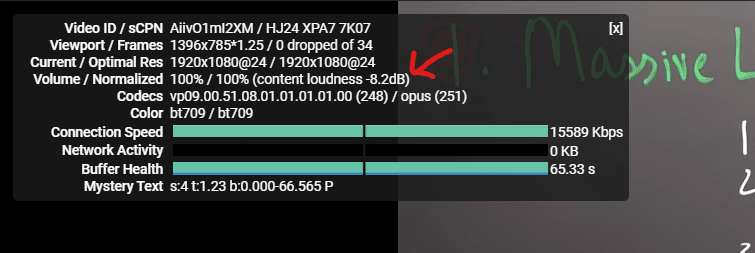
As you can see, YouTube is saying that the audio loudness is 8.2dB lower than it should be.
This should be your first red flag. If you are just a couple of dB in minus it won’t be such a big deal, but -8.2dB is too much!
This is the problem since YouTube will not bring your audio loudness up even if there is enough headroom to do so. This should be the first thing you should watch for.
Let’s analyze audio with Youlean Loudness Meter to show you what is going on
If we look at the Integrated loudness, we will see we are at -22.2 LUFS.

If we do the math and subtract YouTube target from video loudness (-14 LUFS) – (-22.2 LUFS), we will see that there is a difference of 8.2dB. Keep in mind that we can interchangeably use dB and LUFS here since a 1 dB increase of gain will be equal to 1 LUFS increase in loudness and vice versa.
Since we are 8.2dB below the -14 LUFS target, YouTube will add a minus before the number, giving us a -8.2dB as a final value in the stats for nerds info.
Where is the problem in the video then?
For that, we will need to take a look at the loudness graph.
I cannot state enough how important the graph is! Even if you automatically normalize audio to the correct levels, you won’t know if the audio is sounding good unless you take a look at the graph.
Here is the graph of the video where you can clearly see the problem (marked).
I have downloaded the mp3 version of the video, but you can analyze mp4 video files with the meter. (Videos that I have downloaded from YouTube work in 720p resolution or lower, which will have a bit lower quality audio)
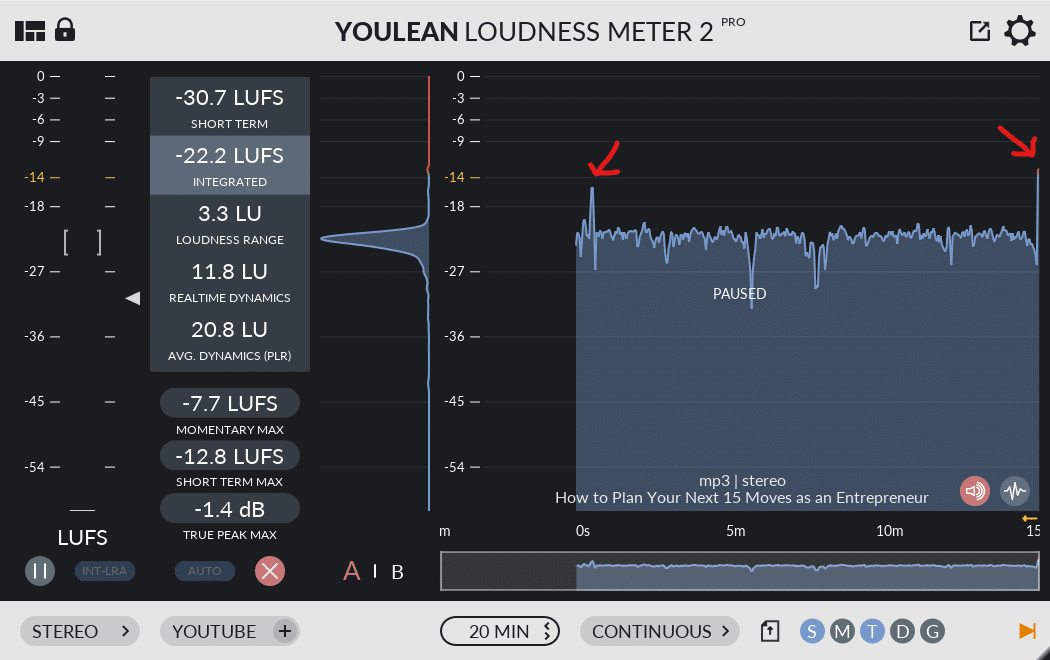
If we look at the graph, we can see that the loudness is fairly consistent, but there are two spots where loudness is significantly higher!
This is what is problematic with this video! If you play the audio, you will see that intro and the outro is too loud. One simple mistake that will ruin your audio loudness!
If you are producing a podcast, show, or any other video content, you should always be making sure to have fairly consistent audio loudness!
A simple look at the LUFS graphs will tell you everything you need to know.
In this particular case, intro and outro music is too loud, which made the voice too quiet. That won’t be a problem if the video is about the intro and outro, but I don’t think Patrick was aiming for that here.
This difference in loudness will be particularly noticeable if the users are watching on laptop speakers or other small speakers! I would say that many won’t be able to watch this video on MacBook speakers for example.
How to fix the loud intro and outro?
It’s simple actually!
Just bring down the volume of intro and outro so that it has the same loudness as the rest of the video and bring everything up until you reach -14 LUFS.
Here is how the fixed audio will look:
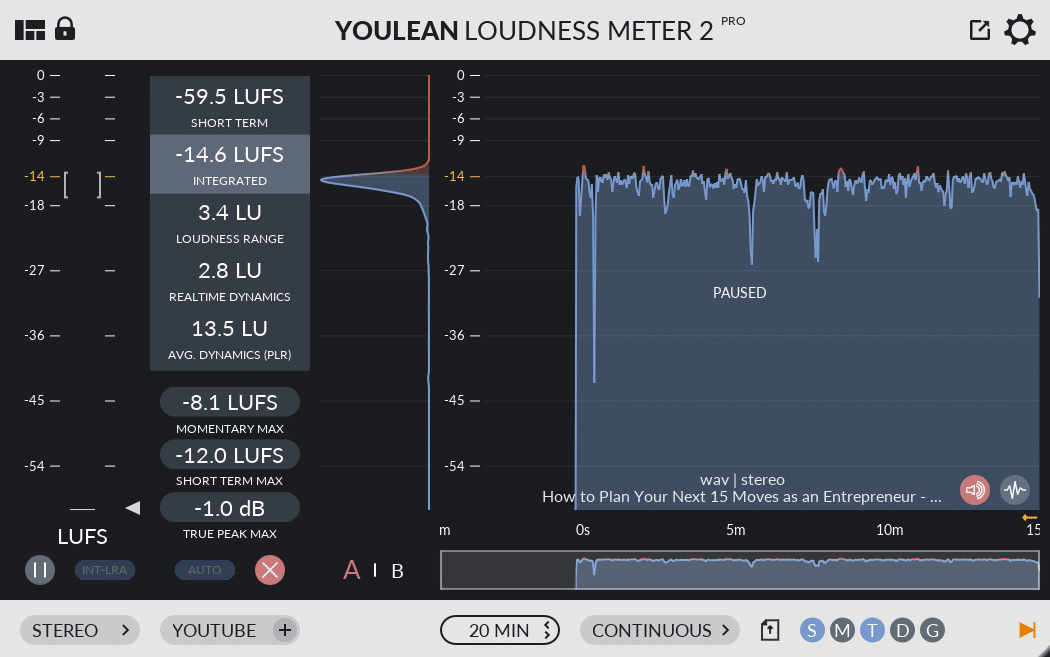
As you can see, the loudness graph is much more consistent. Also, I have normalized audio to a ruffly -14 LUFS and -1 dB true peak max.
Note that I could go to -15 LUFS or a bit lower. You don’t really need to hit the -14 LUFS exactly, but keep in mind that your video will sound a bit lower in volume.
If you go above -14 LUFS, YouTube will bring the audio loudness down so you actually can’t go wrong if you are over -14 LUFS, just make sure to keep true peaks at -1 dB or less.
Now, how the fixed audio sounds?
Here are examples of both. Listen to it on laptop internal speakers to hear the greatest difference. The difference will be apparent even if you have great external speakers!
Note that the mobile phones (iOS and Android) will automatically apply audio compression on every audio that is coming via internal speakers, so you might not notice a difference unless you use the headphones.
Original Video
Fixed audio loudness (Unlisted, 720p)
NOTE: This video is used for educational purposes only and it will be removed if requested by the Valuetainment YouTube channel.
What video sounds better? Original or fixed?
If you ask me, there is no competition.
Fixed audio is much better and louder, and I can finally hear what Patrick is saying on my MacBook speakers!
What about other YouTube channels? Are they having the correct audio loudness?
Well, mostly no it seems!
Here are a few examples of recent videos that I’ve noticed having audio loudness problems:
Marques Brownlee – MKBHD
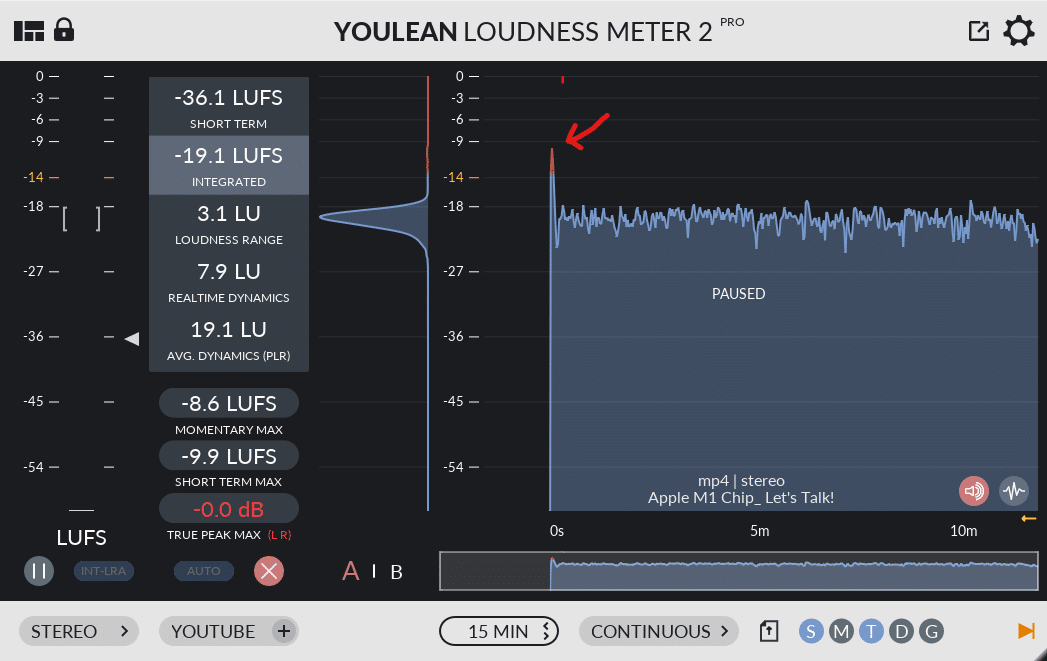
Too loud intro compared to voice. Wasted 5dB of audio loudness.
Economics Explained

Nice and consistent loudness graph, but uploaded with a lower loudness that needed. If you look at true peaks, you can see that 3.6 dB is wasted by just not increasing the volume. If you add a bit of compression to this, the total wasted loudness is about 9.9dB!
JerryRigEverything
Too loud intro, among the other stuff. Wasted 6.4dB of audio loudness.
Wendover Productions
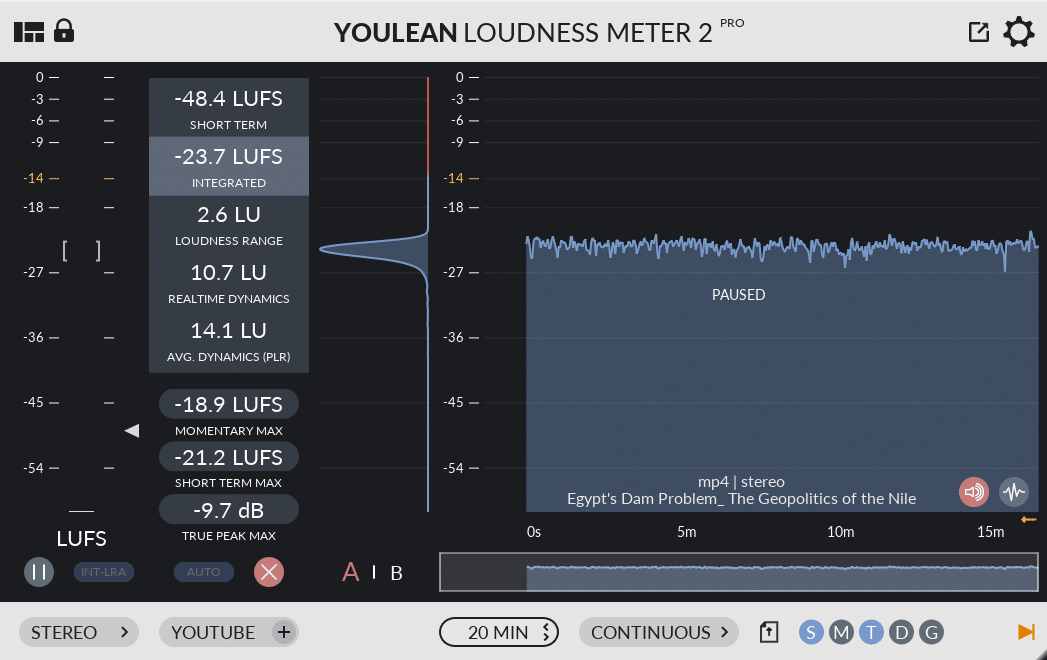
Everything was mixed great, but uploaded too quiet! I am guessing that they were aiming for -23/-24 LUFS which is a TV standard, but this is not valid for YouTube!
Could it be that these YouTubers choose purposely to have audio loudness like in the examples above?
Sure!
They could decide to upload with a lower audio loudness and maybe they did do that in the examples above.
However, while I was researching this, I have noticed that really big channels almost always have good audio loudness.
I would argue that if you are not sounding loud enough, it is not possible to build a big channel. Simply, other videos will sound “better” just because the audio loudness is higher.
You can go a few dB quieter than you should be, but be aware of that!
Let’s summarize what you should do to achieve good audio loudness!
- Use loudness meter that will show you a graph like free Youlean Loudness Meter
- Make sure that the loudness is fairly consistent throughout the video
- Make sure that the intro/outro is having a similar loudness compared to the voice
- If needed, compress audio
- Use any kind of limiter with a true peak detection to limit the audio peaks at -1 db true peak max
- Make sure that your video integrated loudness is around -14 LUFS
Share this with every YouTuber you know!
Well, if they are your competitors, you may keep quiet, but if you have a friend that is making content for YouTube let them know! You will help them greatly on their path to becoming a successful channel, and I am sure they will appreciate this knowledge a lot! Let’s together improve the awesome YouTube platform! ![]()
If you are producing videos, I am sure that this helped you greatly in understanding the audio loudness on YouTube!
As for me personally, I don’t prefer writing blog posts, I would much rather do programming, but this is too important not to know. You could also say that I am a bit selfish and I don’t want to adjust the volume anymore, so YouTubers, fix your audio, please. ![]()
If you have any questions, suggestions, or you want to analyze your favorite YouTube video, let me know in the comments below!


Nice post! I notice a lot of youtube channels – especially newer/smaller YouTubers – have music way too loud and voices way too quiet. Combined with poor quality/cheaper mics and worse recording techniques, it can be hard to understand what they’re saying.
(I own and love your meter btw. Goes in every track on my projects.)
Thanks! This is exactly what is the problem. Fortunately, it is easy to fix once you know what is going on with the audio loudness. 🙂
I’ve always wanted to find a way to explain this to the video editors that work with me, but never had the patience to write it down. This is great. I’m definitely sharing this with my team. Very nice job as always! Thanks a lot!
Thank you so much! If something is not clear for your teammates, let me know so I can update the article!
Hi Julijan, really great how you are explaining the issue. I use your PRO meter constantly.
Thank you so much Viola! 😉
Hi Youlean! I enjoyed this article and love your blog and wish you wrote more often! I specially value the in-depth writings like the last one, while this new one here is also cool to have and I will share it with my students, so they can get a better understanding of the whole loudness normalization issue! Thank you!
Thank you Morfi! I really needed to write this down. There are too many issues with the audio loudness on YouTube currently!
Thanks a bunch!
I have been battling my settings so that my Live Streams sound good. I have audio hijack applying EQ, compression, and limiter dynamically. Now I have this meter in the pipeline and this article is showing me how to use it properly!
I noticed a perfect channel that had sound of -0.2 on Stats for Nerds. Well duh, the channel is for a pro record producer turned YouTuber. Of COURSE he knows how to mix audio!
And now YOU have given me the tools to do it just the same, whether it’s through Audio Hijack, or mixing audio in Final Cut Pro.
Thanks so much! It’s awesome that you managed to fix the audio on your live streams. I did write this article because many people have problems with the audio loudness, but once you know what is going on, it’s an easy fix. Share this with your friends who are doing the video content. Help them to have better audio too. 🙂
Hello
When Youtube reduces the volume of a video, is there a risk of saturation or distortion of the soundtrack due to an algorithm that does not take into account the quality but only the level ?
Thank you for your reply.
YouTube won’t compress audio it will just lower its volume.
Hi Julijan,
This is a great tool (I purchased the Pro version!)
But I’d like a confirmation. I mainly use it for music soundtracks in YT videos.
I just want to make sure that YT bots will NOT modify the audio (in particular compressing it). Do I just have to respect the LUFS Integrated value shown by the graph by not going over -14dB at any time ?
Thanks
You should just be at -14 LUFS integrated and that’s it.
Thanks really 🙏🙏🙏
Great reading this. However, the video as mentioned from the Valuetainment channel has a loud intro and end yes, but overall, it’s the Integrated LUF value that counts and the true peak level, if I understand correctly? As we see, the Integrated level is -22db, so yes, a waste of roughly 8db. I’m not convinced the loud intro/end caused YouTube to lower the volume. I blame the original audio and upload, just being to low in volume overall. If mixed properly by the mastering engineer, considering not the peak but the integrated LUF level, all would have been fine. Correct me if I’m wrong.
Integrated loudness does count, and if you upload video with -14 LUFS Integrated and have loud intro and really quiet rest of the video, you will still have a problem even though you are at -14 LUFS.
In this case, the intro will mostly contribute to the -14 LUFS reading, but if you exclude intro, you will see that the rest of the video is at much lower level. That’s why it is important to look at the whole graph and not just integrated value.
Hi Julijan!
I bought your plugin in order to level out my audio for my videos.
Could you please explain to me a bit how do LUFS compare to DB?
1 LUFS equals 1 db?
If you want to see the integrated LUFS one LUFS quieter, you need to drag the input gain down by 1dB, right?
Looking forward to your reply!
It is something like that, however this is not 100% correct. In most cases 1dB gain will increase 1 LUFS, but not always.